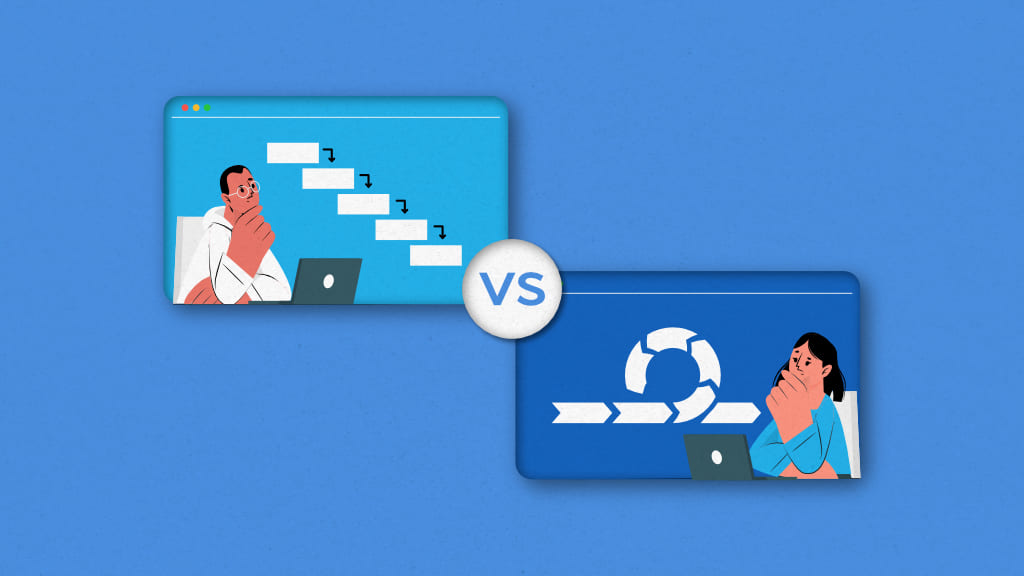Traditional vs Agile project management: which is better methodology? It is still a hot topic of discussion even after two decades of the launch of Agile for software development. Many have answered the question and ended the debate straightway with an argument: in an increasingly complex world, we need an adaptive and agile approach to project management.
While those who have been controlling and managing projects for years using traditional project management are still confused, how can they let go of the control, certainty, and clarity of the Waterfall model, just because a new approach is popular?
Well, the truth is that the complexity of software development projects has increased and we need an adaptive and Agile approach. Even in the development of our product, ProofHub, we made a paradigm shift in our approach in 2018 by shifting to an Agile software development process from the traditional approach.
I onboarded Manu Sood, a Professional Scrum Master, and now, Product Manager at ProofHub, to lead the shift. The purpose is to ensure our product is in alignment with the end-users expectations and changing trends of the project management software industry.
From my personal experience of working in both project management methodologies, I have gained some key insights. For example, in some cases, Agile is not an ideal approach, such as in construction. Thus, you need to decide the right project management methodology for your business, project, or industry.
A Free guide to help you with proven ways to lead a project from start to finish, without confusion or jargon.

In this post, I will cover both approaches, how they differ from each other, and which one you should choose for your next project.
What is traditional project management?
Traditional project management is an established methodology where projects follow a sequential and linear process. It is based on the PMBOK (Project Management Body of Knowledge) Guide that divides project management into five processes or phases:
- Initiation
- Planning
- Execution
- Monitoring
- Closure
Traditional project management is also known as Waterfall methodology because it follows a linear and sequential development process. One phase must be completed before the beginning of the next.
The core characteristics of this methodology are upfront planning, extensive documentation, enhanced visibility, and change control. It is used for projects with fixed scope or requirements.
Advantages & disadvantages of traditional project management methodology
Advantages of traditional project management methodology
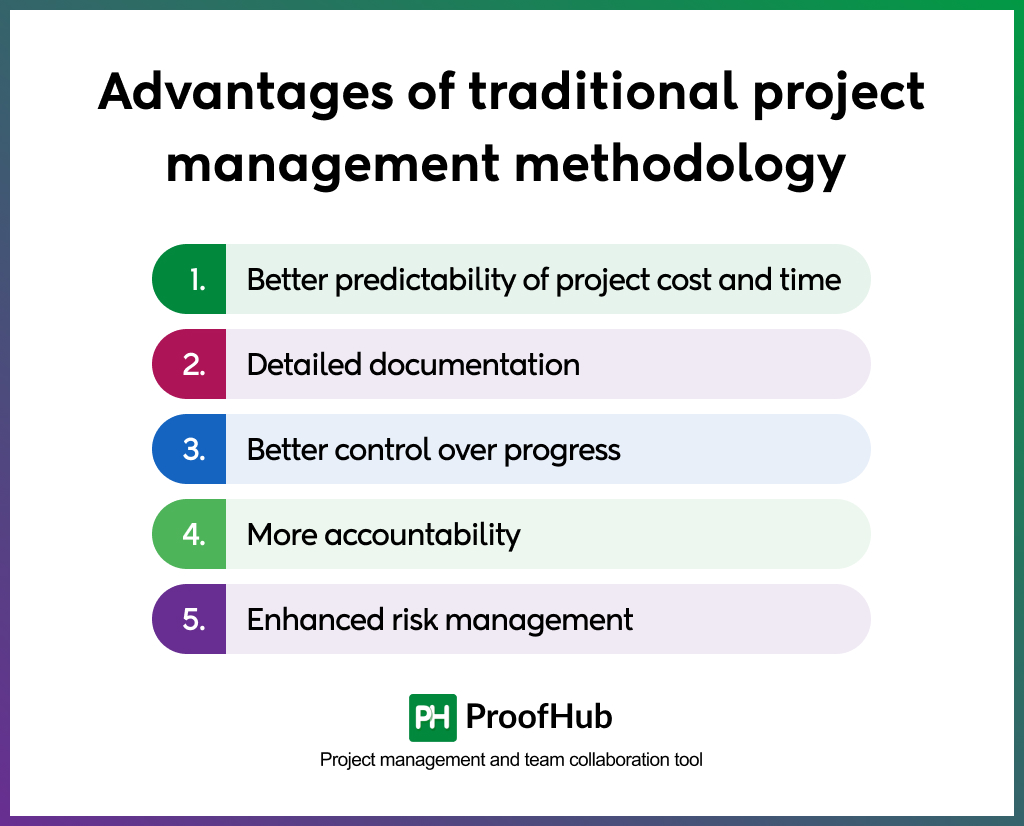
Due to the sequential approach and defined structure, traditional project management offers a range of benefits. Have a look at some of them.
1. Better predictability of project cost and time
Traditional project management involves detailed planning of the project based on the requirements outlined during the initiation stage. This helps identify and document resource requirements, set milestones, and clearly define deliverables, leaving little room for ambiguity. This enhanced clarity allows for better predictability and accurate estimates of a project’s timeline and cost.
2. Detailed documentation
Traditional project management relies on extensive project documentation. It includes a project plan, project requirements, feature specifications, and resource plan. By putting everything in writing in detail, the team gets a clear set of instructions. Everyone knows what needs to be done, how to do it, and when it should be finished. It helps avoid confusion and ensures the project doesn’t deviate from the predicted timeline.
3. Better control over progress
The structured phasic approach of traditional project management provides better control over the project. Each phase has specific processes and checkpoints to ensure projects do not deviate from the original course. With tools like the critical path method on the Gantt chart, stakeholders can anticipate outcomes and project managers maintain order and manage risks effectively throughout the project lifecycle.
4. More accountability
In traditional project management, roles and responsibilities are typically well-defined from the beginning. With detailed milestones and deliverables laid out at the start, holding individuals and teams accountable for their contributions becomes easier. Each team member knows what is expected of them, and there is clarity about who is responsible for which tasks. This clear delineation of roles contributes to better accountability and quality control.
5. Enhanced risk management
Traditional project management relies on upfront planning to find out potential risks and plan mitigation measures for a project. For small projects with fixed scope, this approach helps you allocate sufficient funds and buffer time for anticipated risks. Additionally, the project follows a linear and sequential approach with defined attributes. With continuous tracking using the Baseline in the Gantt chart, project managers can easily identify deviations from the original plan for effective change management.
Planning your projects using traditional project management?
Use ProofHub Gantt chart software to create a project roadmap and set and manage task dependencies!
Disadvantages of traditional project management methodology
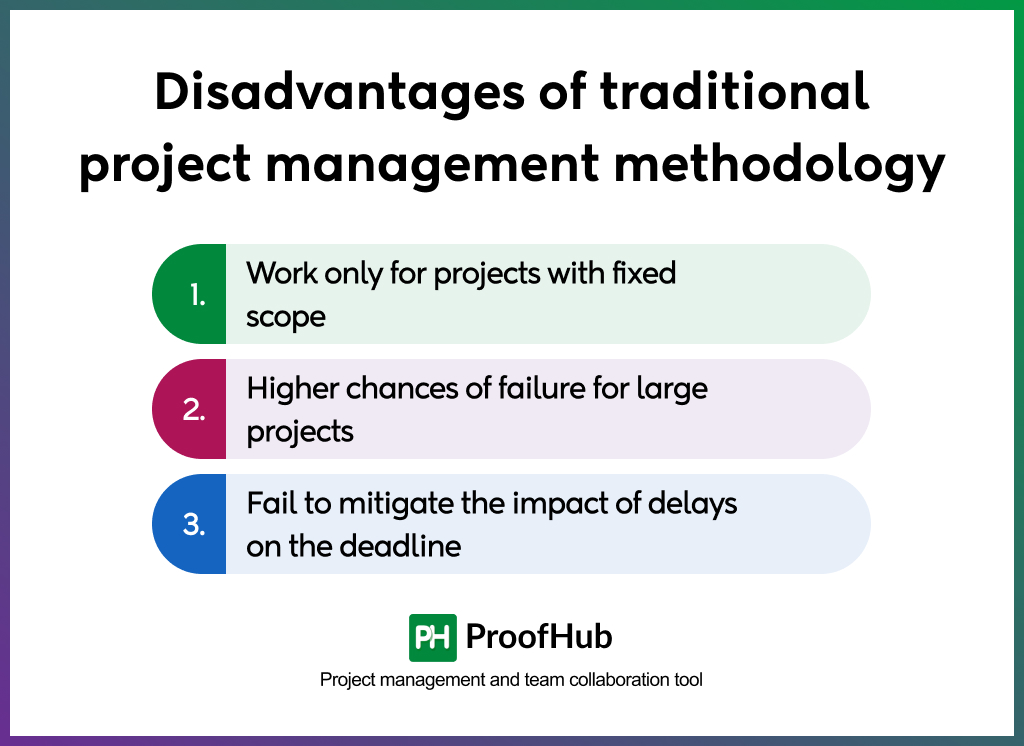
Traditional project management has some significant disadvantages for some industries when it comes to managing projects today. Have a look at the common disadvantages.
1. Work only for projects with fixed scope
Due to the sequential, linear, and rigid approach, traditional project management is ideal for projects with fixed scope. It is not designed to respond to change. Any change in the original requirements requires you to re-run the estimate of the project timeline and costs. This approach works fine for projects with predictable outcomes and recurring processes.
2. Higher chances of failure for large projects
Traditional project management requires the completion of one phase before the next begins and follows the traditional phases of project management. Hence, it focuses on one big launch of the project. Due to this, customer feedback is utilized at the last stage. This leads to higher chances of project failure because end-users requirements and expectations may have been changed in the long term.
Moreover, end-users and client feedback are not involved during the development stage. This may lead to the development of products that customers or clients do not want.
3. Fail to mitigate the impact of delays on the deadline
In traditional project management, there is no way to prevent the impact of delay in one phase to other phases. Also, there is trouble with disjointed teams. If a bottleneck is in the designing stage, developers cannot help designers and have to wait for the design team to fix the bottleneck and move ahead.
Resorting to these drawbacks, software developers had developed a new set of practices and named it, ‘Agile project management methodology’.
Let’s understand it.
What is Agile project management?
Agile is a project management methodology that follows an iterative approach to project management. It includes working in short iterations, continuous-release, and incorporating end-users feedback after each iteration.
This approach does not focus on creating the final picture of the project upfront but rather on gathering requirements and feedback from stakeholders throughout the development process. Thus, there is no pressure of rigid final delivery deadlines. It relies heavily on teamwork, collaboration, timeboxing tasks, and the flexibility to respond to change as quickly as possible.
Agile project management is based on the Agile Manifesto for software development which has four essential values:
- Individuals and interactions over processes and tools
- Working software over comprehensive documentation
- Customer collaboration over contract negotiation
- Responding to change over following a plan
Agile methodology is ideal for projects where a client does not have a clear idea of the final product or projects with changing feature requirements in a dynamic industry such as software development. However, this approach can be applied to other projects such as marketing and finance.
Advantages of Agile project management methodology
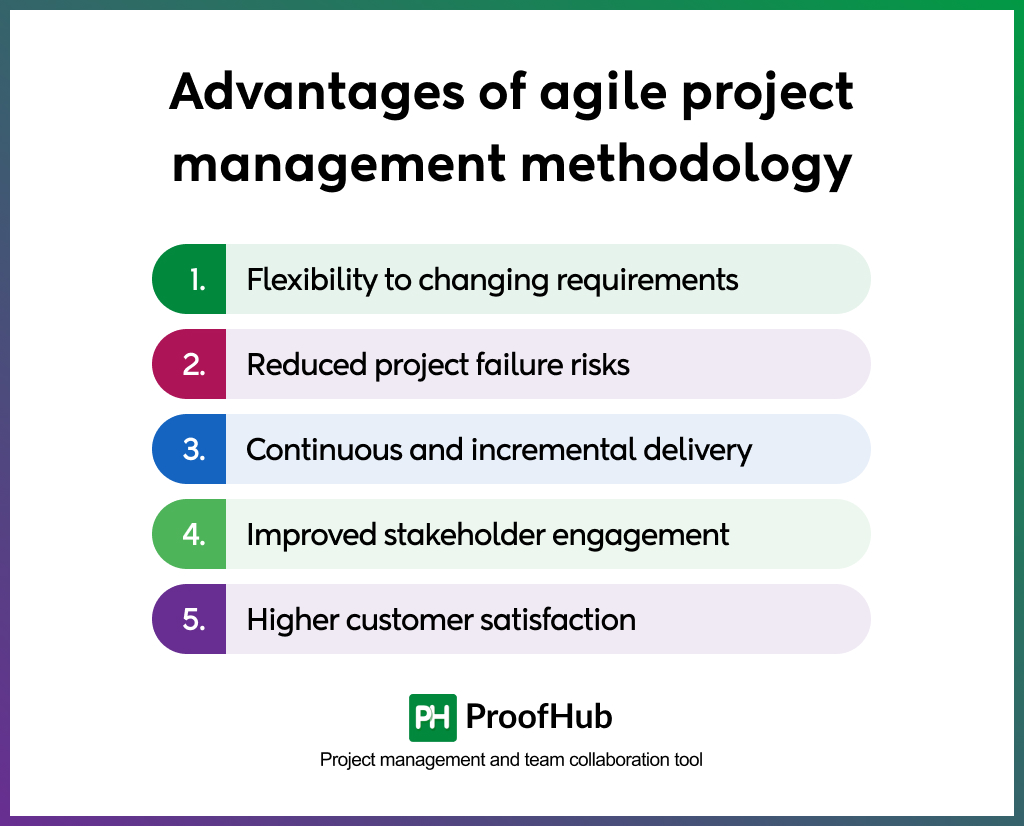
Due to flexibility and adaptability, Agile project management offers a range of benefits. Have a look at some of them.
Agile methodology has two main frameworks for managing projects: Kanban and Scrum. We are here referring to the Scrum while discussing benefits.
1. Flexibility to changing requirements
Agile is designed to be adaptive and flexible to changes. It follows an iterative process where projects are divided into sprints of a shorter span. Unlike the traditional approach, less time is spent on upfront planning and prioritization. Its short and iterative nature allows teams to respond to the change quickly with strategy. Instead of resisting changes to project requirements, Agile teams incorporate them into their workflow, fostering a more responsive and adaptive project environment.
2. Reduced project failure risks
In Agile, the project is divided into small parts called “Sprints.” After each Sprint, you get to see a deliverable part of the project of the end-customer value. If there’s anything you want to tweak or change, it’s easier and less risky to do it at this stage by receiving customer feedback. You follow this process of frequent check-ins, quick adjustments, and continual development throughout the development. This ensures the end product aligns closely with stakeholders’ vision and customers’ needs, leading to reduced risk of investing time and money in a project that might not turn out as expected.
3. Continuous and incremental delivery
Continuous delivery is a fundamental aspect of Agile project management. After each sprint, a working and usable portion of the project is delivered to the customer. This iterative approach ensures that there is consistent progress and improvement throughout the project timeline, resulting in improved efficiency and speed-to-market. Users can benefit from early versions of the product.
4. Improved stakeholder engagement
Agile involves stakeholders throughout the project. This continuous engagement and getting approvals before delivery of each iteration ensure transparency and adaptation of changes and improvements requested by stakeholders. Also, when functionalities are developed and showcased incrementally, stakeholders witness tangible results at the end of each iteration, resulting in improved satisfaction as the project evolves.
5. Higher customer satisfaction
Agile focuses on customer collaboration and feedback. The iterative and incremental nature of Agile projects keeps customers actively involved throughout the development process. Regular feedback loops allow customers to offer insights, suggestions, and changes at various stages of the project. This continuous involvement and data sharing ensures that the final product aligns closely with the customer’s vision and expectations. It also leads to innovation and creativity based on enhanced understanding. As a result, the customer is more satisfied with the end product, leading to a positive customer experience.
Disadvantages of Agile project management methodology
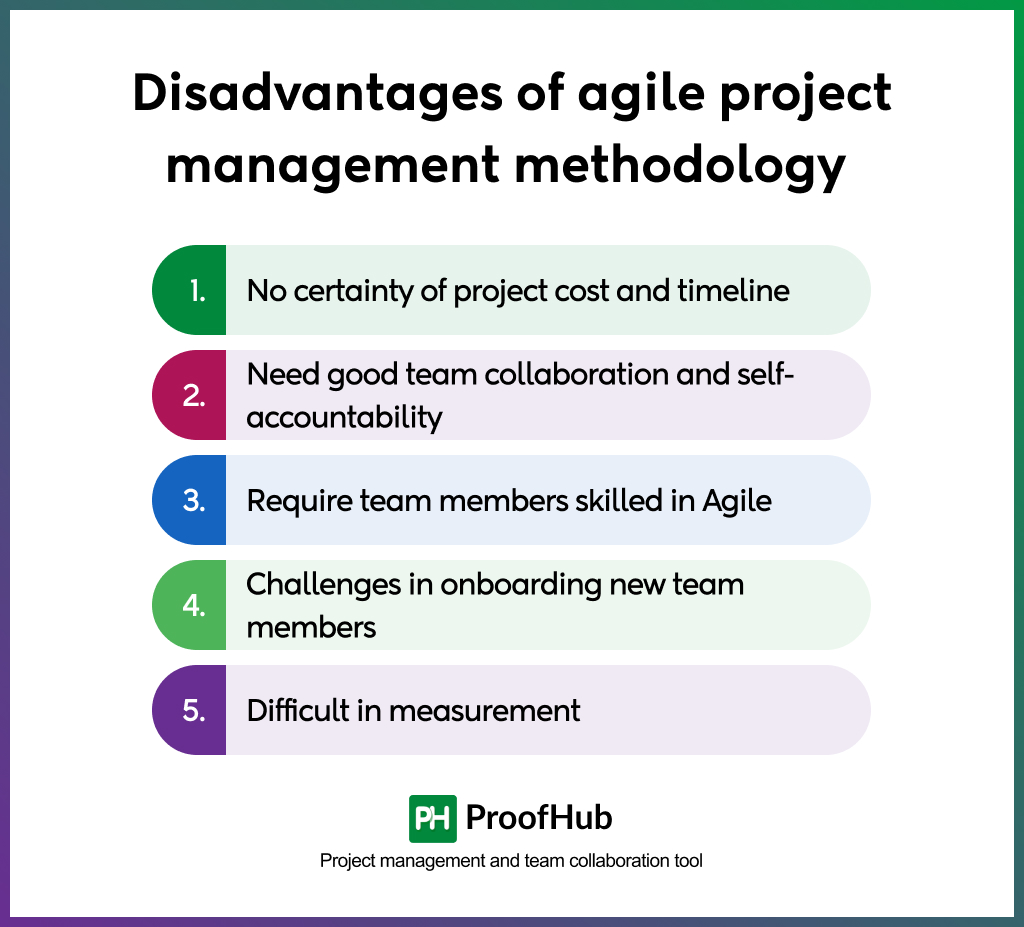
Just like any project management methodology, Agile project management is also not without disadvantages. Have a look at the common disadvantages.
1. No certainty of project cost and timeline
Agile methodology does not talk about defining the project’s final delivery date and cost upfront because it changes as per the requirements. Thus, it is hard to predict the cost, time, and resources of the project. You do not get the certainty and predictability of the Waterfall because the project scope is changing and evolving. You can only create a resource allocation plan and predict the outcomes for a sprint.
2. Need good team collaboration and self-accountability
Agile prioritizes working software and team collaboration over comprehensive documentation. There are no extensive hundreds of pages of documentation in Agile to tell you about the complete story of a project. All you have is the product backlog, prioritized features to be committed in the sprint, and a detailed description of the features and acceptance criteria for quality management. The way you will approach a project and the work completed on a project is discussed every morning in daily standup. Thus, the project team needs frequent communication and collaboration to function.
3. Require team members skilled in Agile
In Agile methodology, self-organizing and cross-functional Agile teams make decisions about how much work they can complete in a sprint and how the work will be distributed. There is no project manager to prioritize and distribute work. You might feel a lack of control over the team, but Agile runs on trust, transparency, and continuous improvement.
Your team members need to have self-accountability and be able to work without supervision. You might have to invest in Agile learning of the team and training of the management to make the organization ready to use Agile software development processes.
4. Challenges in onboarding new team members
Lack of project documentation and insufficient records of project history make it difficult for new team members to understand the project and its context. It also poses challenges in long-term project maintenance, knowledge transfer of the project, and ensuring customer service.
5. Difficult in measurement
In Agile, there are no clear stages of progress like Waterfall. The lack of a defined end goal in Agile projects makes it challenging to measure progress accurately. This uncertainty makes it difficult to predict workforce requirements and manage workload effectively. It also impacts the accuracy and precision of budget and timeline estimation, especially as projects grow in complexity.
Traditional vs Agile project management: understand the difference
The table below shows the major differences between the traditional vs Agile project management methodologies.
| Characteristics | Agile approach | Traditional approach |
| Approach | Iterative and incremental | Linear and sequential |
| Scale of projects | Small and medium-scale | Large-scale |
| Feature requirements | Dynamic and changing throughout development | Clearly defined before development |
| Cost and time | Variable and changing | Fixed and predictable |
| Involvement of clients | High | Low |
| Development | Incremental and continuous release | Phasic and one big launch |
| Customer Involvement | Customers are involved throughout development for insights and feedback | Customers are involved at the initiation for insights and before the launch for feedback |
| Model | Agile model favors adaption, Flexible | Traditional model favors anticipation, rigid |
| Team | Self-organizing, cross-functional, and collaborative | Traditional, departmental, and siloed |
| Documentation | Focus on working software and defining feature requirements | Comprehensive and extensive |
| Work management | Agile team decides and commits to the work and a Scrum Master facilitates meeting | Project manager decides the work and provides estimates |
Why is Agile more preferred than the traditional PM approach?
Many developers and project managers prefer to use the Agile methodology for a variety of reasons. Some of them are discussed below:
1. More flexibility
When it comes to making changes in the product or a process, the Agile methodology is much more flexible than the Waterfall methodology. While working, if team members feel that there is a need to experiment and try something different than planned, the Agile methodology easily allows them to do so. The best thing about this methodology is that it focuses more on the product than following a rigid structure.
Unlike the traditional approach, Agile methodology isn’t linear or follows a top-down approach. This way, all the last-minute changes can be accommodated without affecting the result and disrupting the project schedule.
2. More transparency
In Agile methodology, everything is out there and transparent. The clients and decision-makers are actively involved in the initiation, planning, review, testing, and problem-solving. Whereas in the traditional approach, the project manager holds the reins of the project, thus others don’t get to make the major decisions.
The Agile methodology facilitates team members to view the progress right from the start to the end. This level of transparency plays a significant role in constituting a healthy work environment and collaborative decision-making.
3. Ownership and accountability
One of the striking differences in both project management approaches is the level of ownership and accountability that each provides to team members. In traditional project management, a project manager is in charge of leadership and mentorship, which means that the entire ownership belongs to them.
In the Agile methodology, every team member shares ownership of the project. Each one of them plays an active role in completing the sprint within the estimated time. The team uses collaboration tools like Kanban board for real-time communication and centralization of information to ensure accountability.
4. Constructive feedback
In the traditional approach, every single process is clearly defined and planned from the beginning of the project. The project has to be completed within the estimated time and budget. So, any big change or feedback that might push the deadline is skipped. At the same time, Agile management allows constant feedback that helps provide better output.
Due to the high acceptance of feedback in Agile methodology, it has become the first choice for many project managers for developing applications & software. They can respond to customer requests as customers get to validate each iteration to deliver a high-quality product or service within the delivery time.
5. Project completion
Traditional project management methodology is majorly used for small or less complex projects owing to its linear nature. As discussed earlier, this methodology does not embrace sudden changes and avoids them strictly as it would take the team back to the first stage.
Whereas, Agile is your best bet in terms of managing large and complex projects. The iterative approach helps you respond to changes happening over time and manage multiple interconnected phases or stages depending on one another.
How to choose between Agile project management vs traditional project management?
In reality, there is no ‘one-size-fits-all’ methodology suitable for every project or organization. The choice to implement a method primarily depends on factors such as the nature of the project, size, and resources involved, among others.
Most of the time, intelligent project managers decide the methodology to adopt during the initiation of the project. They take the final call in agreement with other project sponsors and people involved in the project planning process.
Mentioned below are some factors you can take into consideration while choosing a suitable methodology for your project.
- Take a look at the project requirements: Are the requirements clear? If project requirements are unclear or tend to change, choose the Agile methodology. And, the traditional method fits best in a situation where the conditions are clearly defined and well understood from the first instance
- Consider the technology involved in the project: The traditional project management methodology is more appropriate if no new technology or tools are applied. Agile methods allow more space for experimentation with the latest technology as it is more flexible than the traditional approach.
- Is the project prone to unwanted risks and threats: Considering the rigid nature of the traditional methodology, it’s not advisable to go with this methodology. However, risks can be addressed sooner in the Agile approach, and it seems like a better option in terms of risk management.
- Availability of resources: The traditional approach works best with significant and complex teams and projects with limited and fixed resources. Whereas Agile project management works best for projects with flexible budgets and time schedules.
- Complexity of project: The criticality of an end product depends a lot on the nature of the chosen project management methodology. As the traditional method involves documentation, it is very much suitable for critical products compared to the Agile project management methodology.
Looking for Agile project management tools?
Check out: 18 best agile project management tools for project managers
Conclusion
Traditional vs Agile project management: which is the best? Well, we clearly learned that the right choice of methodology depends on your needs, industry, and project. But in general, considering the dynamic nature of businesses these days, where changes happen every moment, Agile turns out to be a clear winner due to its adaptability, flexibility, and transparency. That’s why you see more than 70% of businesses using Agile.
Agile involves developers, end-users, and clients throughout the software development process for more rewarding experience than the siloed traditional approach to project management. Agile methodology is a better option for companies looking for high quality, better business value, improved productivity, lower costs, and enhanced speed-to-market.
FAQs
How to prepare your organization for the shift to Agile?
Shifting to Agile methodology is not just about adopting a project management methodology for a project. It requires a shift of mindset for all, from leadership to employees. It is a new way of working which may challenge the traditional hierarchy and power balance. Both leadership and employees need training to understand the principles, values, and mindset of Agile methodology.
Can Agile and Traditional methodologies be combined?
Yes, Agile and Traditional methodologies can be combined to create a hybrid project management approach. The purpose of combining two methodologies is to offer the best of the both worlds: the stability of Waterfall and the flexibility of Agile. However, it requires extensive experience and knowledge to successfully combine both methodologies.
What is hybrid project management?
Hybrid project management is a project management methodology that combines the principles of both Agile and traditional approaches. It creates an entirely new project management methodology where projects are planned using Waterfall techniques while development is carried out using Agile techniques. Thus, you get the best of both worlds.
What is the difference between traditional PMO and Agile PMO?
In Traditional PMO, project requirements are often defined upfront and documented in a project charter, allowing for more certainty in planning but less flexibility. Whereas in Agile PMO, project requirements are documented as user stories that are prioritized and developed iteratively throughout the project, enabling greater flexibility in responding to changing needs.
Traditional vs Agile vs hybrid project management: what is the difference?
Traditional project management follows a linear and sequential approach.
Agile project management follows an iterative and incremental approach.
Hybrid project management combines elements of both traditional and agile approaches.
Is Agile suitable for non-software projects?
Yes, Agile is suitable for non-software projects. Increasing number of companies from the marketing, finance, and customer service industry are using Agile methodology to achieve better results.
